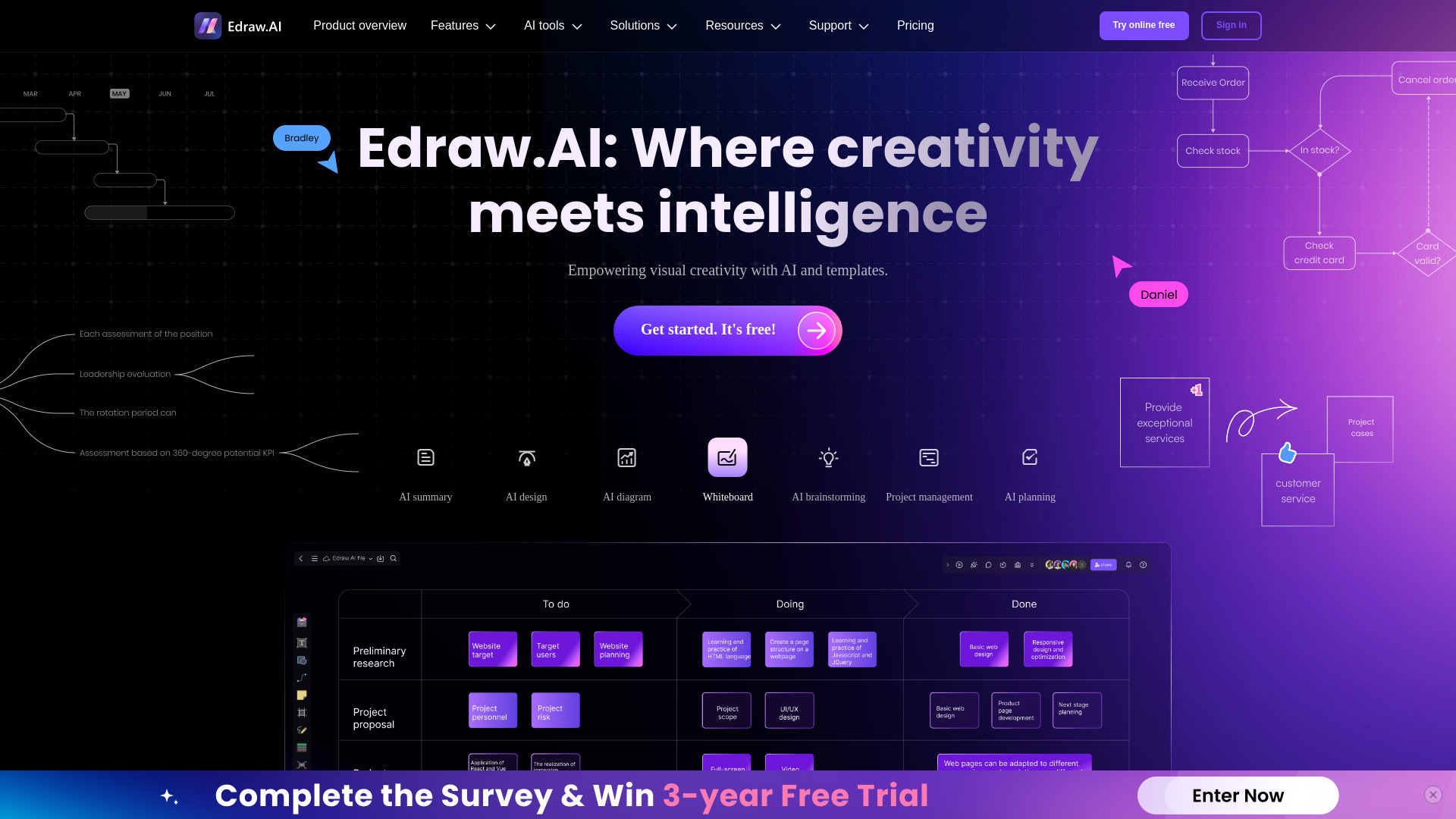- Home
- AI Design Generator
- Edraw AI

Edraw AI
Open Website-
Tool Introduction:40+ AI tools for flowcharts, mind maps, and smoother teamwork.
-
Inclusion Date:Oct 21, 2025
-
Social Media & Email:
Tool Information
What is Edraw AI
Edraw AI is an AI-powered visual collaboration platform that turns ideas and requirements into clear, actionable diagrams in minutes. Combining 40+ AI tools with professionally designed templates, it automates flowchart and mind map creation, accelerates project planning, and streamlines cross‑functional communication. Teams can brainstorm, map processes, and document systems with fewer meetings and faster feedback loops. By centralizing diagram generation, editing, and review, Edraw AI helps product, engineering, research, marketing, consulting, education, and IT teams align quickly and deliver with confidence.
Edraw AI Main Features
- Prompt-to-diagram generation: Create flowcharts, mind maps, and outlines from natural language descriptions, reducing manual drawing time.
- Template library: Start fast with finely designed templates for processes, roadmaps, org charts, and more.
- AI-assisted refinement: Auto-add steps, reorganize branches, and suggest labels to improve clarity and structure.
- Brainstorming support: Expand ideas, cluster topics, and turn notes into visual maps that are easy to share.
- Process visualization: Map workflows, decision trees, and dependencies to reveal bottlenecks and handoffs.
- Collaboration and feedback: Share diagrams, collect comments, and iterate in a shared workspace.
- Readable documentation: Generate summaries and explanations to pair visuals with concise text.
- Flexible export: Save and export to common formats for presentations, reports, or handoffs.
Who Should Use Edraw AI
Edraw AI is ideal for teams that need fast, accurate visuals to align stakeholders: project managers planning sprints and milestones; engineers and IT mapping systems and incident flows; researchers structuring insights; marketers outlining campaigns; consultants documenting processes; and educators creating lesson maps or study guides.
How to Use Edraw AI
- Create an account and open a new workspace or project.
- Select a template such as a flowchart, mind map, org chart, or roadmap.
- Enter a prompt or paste requirements; let the AI generate an initial diagram.
- Refine with AI suggestions: add steps, reorganize branches, and adjust labels.
- Customize styles, colors, and icons to match your team’s guidelines.
- Share for review, gather comments, and iterate until the diagram is approved.
- Export to a common format and attach it to specs, decks, or knowledge bases.
Edraw AI Industry Use Cases
In software development, teams convert user stories into flowcharts to clarify acceptance paths; in IT operations, incident responders map runbooks and escalation routes; in marketing, planners outline campaign funnels and content calendars; in consulting, analysts document client processes to reveal inefficiencies; in education, instructors build mind maps for courses and students create study guides from lecture notes.
Edraw AI Pros and Cons
Pros:
- Rapid prompt-based creation of flowcharts and mind maps.
- High-quality templates that shorten setup time.
- Clear visualization of complex workflows and decisions.
- Helpful AI suggestions to improve structure and readability.
- Supports collaboration and faster stakeholder alignment.
Cons:
- AI-generated diagrams may require human review and edits for accuracy.
- Very complex or niche notations may need manual refinement.
- Some advanced features may only be available on paid plans.
- Effective results depend on clear, well-structured prompts.
Edraw AI Popular Questions
-
Question 1: Can Edraw AI generate diagrams from plain text?
Yes. You can describe a process or outline topics, and the AI will create an initial flowchart or mind map.
-
Question 2: Can I edit the AI’s output?
Absolutely. You can add or remove steps, reorganize branches, change styles, and fine-tune labels.
-
Question 3: Is Edraw AI useful for technical teams?
Yes. Engineering and IT teams use it to map architectures, runbooks, integrations, and decision trees.
-
Question 4: Does it support collaboration?
Yes. Diagrams can be shared for review so teammates can comment and iterate together.
-
Question 5: How reliable are AI-generated diagrams?
They provide a strong starting point, but best practice is to review and refine before publishing.


